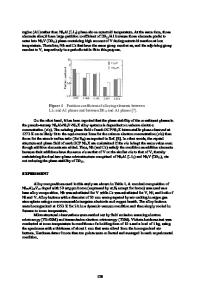Study of Point Defects in Intermetallic Compound Ni 3 Al
- PDF / 429,351 Bytes
- 6 Pages / 420.48 x 639 pts Page_size
- 101 Downloads / 448 Views
STUDY OF POINT DEFECTS IN INTERMETALLIC COMPOUND Ni3A! DONGLIANG LIN (T.L. Lin) AND JIAN SUN Department of Materials Science and Engineering, Shanghai JiaoTong University, Shanghai 200030, P. R. China ABSTRACT Formation energies of point defects in Ni5 Al were calculated by EAM and static relaxations. The equilibrium equation of point defects in LI1 type of intermetallic compounds was established. The concentration of point defects at 1000 K as a function of bulk composition and the effect of temperature on them was calculated for Ni3AI. The concentration of vacancies in Ni3Al with various Al and boron contents was also investigated by means of positron annihilation to verify the calculated results. INTRODUCTION Aoki and Izumi[1] first discovered that microalloying with boron suppresses intergranular fracture and improve the ductility of NiAl, which generated considerable interest in both grain boundary phenomena and the lattice defect in Ni 3Al. The results studied by Liu et al.[2] showed that an increase of aluminium from 24 at % to 25.2 at % results in a reduction of boron segregation to grain boundary by 45%. Since the grain boundary properties in Ni 3AI are sensitive to the boron level, the boundary remains brittle when the amount of boron segregation is insuffient. Thus, it is highly important to clarify the role of off-stoichiometry in the transport of boron to the grain boundaries. Mass transport usually occurs by atomic migration via point defects. The positron annihilation study of vacancies in NiAl by Dasgupta et al.[3] suggested that there exists small concentration of constitutional Ni vacancies essentially independent of composition in the stoichiometric or hyperstoichiometric alloys. The constitutional vacancies combined with the boron dopant may limit the long range transport of boron to grain boundaries. However, the properties of constitutional point defects in Ni3 Al is not identified theoretically. In the current study, The formation energies of point defects in Ni8 Al, such as antisite defects, vacancies, interstitials were calculated by EAM and static relaxations. The equilibrium equation of point defects in LI1 type of intermetallic compounds was established and the effect of temperature on four types of point defects was studied. The concentration of vacancies in NiAl with various Al and boron contents was also investigated by means of positron annihilation to verify the calculated results. THEORETICAL CALCULATION In this calculation, the embedded atom potentials reported in ref.[4] is used to calculate the formation energies of antisite defects, vacancies and interstitials with the energy gradient method. A cubic cell containing 1728 atoms with periodic boundary condition and constant pressure is adopted. The details of calculations was decribed elsewhere[5]. The calculated results are shown in table I . Table I
Formation energies of the relevent intrinsic point defects in Ni3AI Type of defect Al Vacancy Ni Vacancy A1--1-Ni anti-site Ni--*Al anti-site Al Octahedral Ni Octahedral
AEf (ev)
Data Loading...











